PARISH OF ANNACLONE
by Leo McNeill
Annaclone means `Marsh of the Meadows' (Eanach Cluana).
Alongside it existed the ancient parish of Drumballyroney meaning `Ridge
of O' Rooney's town'. Christianity has been practised in Annaclone from
the time of St. Colman, around 510 A.D., and perhaps earlier. The
townland of Tanvally in the parish means `the old road' and this was
part of the main road from Armagh to Downpatrick. Saint Patrick must
have travelled along this same road on his way to Saul.
From 510 A.D. the Gaelic Chieftains, The Cobha and
the Magennises of lveagh allowed missionaries to say Mass and travel
freely as there was no monastic foundation in the parish. These services
were held in Ardbrin - in the old church beside the lake - and
Aughnavallog (Drumballyroney Church), formerly the sites of pre-Celtic
worship. In 1765, the lake at Ardbrin Church was drained into the River
Bann thus forming an area of bogland. In 1809, Rev. Joseph Martin A.M.
found the famous `Ardbrin Horn' in this bogland. The horn, which dates
back to Celtic times (c. 200 BC), is adjudged to be one of the finest of
its type ever found in Europe. It is now kept in a Dublin museum. The
Synod of Kells, in 1152, may have confirmed the parish of Annaclone with
a church at Ardbrin and the parish of Drumballyroney with a church at
Aughnavallog. These two parishes were united in the post-Reformation era
and became `Annaclone and Drumballyroney'.
The earliest reference to Annaclone parish clergy was
that of a `Canon of Dromore', Peter McGyryn (McGivern), who held lands
in Annaclone during 1427. The next reference was to Odo O'Shyagiel (O'Shiel).
The O'Shiels held the townlands of Aughnacloy and Ballyshiel. Ode
O'Shiel was `Rector of Annaclone', in 1527. Eugene Magennis was `Rector
of Annaclone' in 1539 as well as being Bishop of Down and Connor. In
1611, the Bishop of Dromore granted church lands in Ardbrin, Tanvally
and Lisnasliggan to Patrick McGivern. The McGiverns were a `church
family'. The next surviving record is that of Patrick and Eurny O'Sheal
who held the Annaclone church lands during 1657. (One of these men may
have been a priest).
In 1422, the `Vicar of Drumballyroney' was Comedinus
Mag Uryn (McGivern). In the same year John McFiach was listed as
`Rector'. The next record of 1609 shows James McKay holding the church
lands of Aughnavallog. The McKays were another `church family' and James
McKay may have been a priest. In 1640 he was succeeded by Daniel McKay.
The latter was to serve for a time as acting-Bishop of Dromore. From
1678-1690 the Vicar General of Dromore was Rev. Henry McKay from
Drumballyroney.
A survey carried out for the Church of Ireland
authorities in 1657 mentions "only old walls" of the Annaclone and
Drumballyroney churches still standing. These churches were destroyed
sometime between 1641 and 1649, after Cromwell arrived in Ireland. From
this time onwards the Church of Ireland permanently took over these
churches and graveyards. The Catholics still used the graveyards until
the cemeteries of Annaclone and Magheral were consecrated. At a
Williamite court held in Banbridge, John O'Killen was registered as
Parish Priest of Annaclone. In 1704 at Downpatrick, another register
gives a total of thirty priests operating in County Down with O'Killen
as P.P. of Annaclone and Drumballyroney. He had been ordained by the
Bishop of Dromore, Daniel McKay, in 1674. The next recorded priest was
Fr. Hugh O'Kelly who ministered from 1730-1740. He was one of the
O'Kellys from the townland of Tierkelly (`the land of the O'Kellys') and
hence was a native of Drumballyroney. He was educated on the Continent.
From 1742-1745, Father James Pulleine was Parish
Priest of Annaclone. Father Pulleine was also Dean of Dromore and looked
after the administration of the diocese. He compiled a Catechism for the
diocese of Dromore, written in both Irish and English. It was used from
1782 until 1880 when it was replaced by Bishop Leahy's `Penny
Catechism'. Father Pulleine was a tireless worker during the Penal
times. Part of a sermon of his, preached at the funeral of Eoghan
O'Neill who was buried in Hilltown in 1744, is most poetic, and gives us
a background picture of those dark Penal days: "This island of Ireland
is now a desert without learning, light or faith. It is now clouded over
by ignorance, heresy and darkness. See how this land is now devoid of
churches, without clergy or altars. Nothing now remains of the abodes of
saints but lonely places with empty walls worn away by time and the
elements."

Without churches, the native population was forced to
have Mass said at `Mass Rocks', in barns and in people's houses. There
were four Mass Rocks in the parish - in the townlands of Tierkelly,
Ballynafoy, Ballyroney (on land owned by the McArdles of the Mount) and
in a field of McClorey's at Poland's Bridge. Evidence suggests that
there was a `Mass House' in Magheral during Father Pulleine's time - he
most likely got permission from the Lord of Lisnavaghrog, Cowan of
Anahilt.
In 1742, Fr. Arthur Magennis is noted as being
`Pastor of Ballyroney.' He was, in effect, the curate to Fr. Pulleine.
Fr. Pulleine died in 1775. A small headstone bearing his name is
situated in the middle of Magheral graveyard. In 1778, the Bishop of
Derry administered the Dromore Diocese because the local clergy did not
want Armagh involvement in Dromore affairs. A letter of thanks was sent
to this same bishop on January 20th. 1778. Included among the
signatories was Edmund Derry, `Pastor of Annaghlone and Drumballyroney.'
The next Parish Priest of Annaclone was Patrick McKay. In 1793, Fr.
Henry Collins is listed as Parish Priest of Annaclone.
A nephew of Fr. Hugh O'Kelly, Timothy O'Kelly, became
Parish Priest in 1780. He was interred in the family plot in
Drumballyroney graveyard in 1810. During his pastorate, in 1802, the
first post-Reformation church was constructed in Annaclone on the site
of the present one, only at right angles to it. It was 70' long, 29'
wide and 12' high.
Fr. James McKay, in 1807, built a `Mass House' in
Magheral. According to the inscription on a plaque built into the wall
opposite the present Magheral church, it was subscribed to by people of
all Christian denominations. Fr. McKay was a noted Irish scholar. He
built Magheral School in 1834. It was one of the first schools built in
the Dromore Diocese after the 1831 Education Act.
Fr. McKay was succeeded in 1834 by the Rev. Dr. J. S.
Keenan who, during his pastorate, had the present Annaclone Church
built. He was a man who served in three dioceses - Clogher, Armagh and
Dromore. Dr. Keenan was a classical scholar, famed for his preaching. He
ran an academy in Dundalk where Latin was the spoken language. Dr.
Keenan was also the first president of St. Colman's College in Newry.
Dr. Keenan's time in Annaclone, however, was sometimes turbulent, as he
and Bishop Blake were at loggerheads. Both churches were closed for
almost a year and, as a consequence, Dr. Keenan was suspended by the
bishop. He died in Rome in 1847 and is buried in St. Isidore's cemetery
there. During Dr. Keenan's time, Fr. Thomas Brady became Administrator
from 1839-40 and Fr. John Mackin was appointed Administrator in 1844,
becoming Parish Priest in 1847. In 1851, Fr. Mackin was appointed P.P.
of Gargory. He was lost at sea in 1854. (The appointment of these
`administrators' indicates that trouble was afoot!)
Fr. John Mooney became P.P. in 1851. He built the
present Magheral Church, which replaced the Mass House, in 1857. It was
he who also built Monteith School in 1866, and Tullyorier School, which
was opened in 1861. In 1876, Fr. John Mooney left for Clonduff Parish
and he was replaced by his nephew, Fr. Hugh Mooney, a native of
Annaclone. The latter died in 1889 and is interred in Magheral Cemetery.
A Cabra man, Fr. Henry Devlin, was the next parish priest. He served
from 1889 until 1903. Fr. Devlin died and is interred in Annaclone.

TROUBLED DAYS
Fr. Cornelius Woods became Administrator from 1898
because of Fr. Devlin's poor health and became Parish Priest in 1903. He
had a long reign - until 1932. He was a much loved pastor. He is still
recalled by the older parishioners. He was fond of hunting and kept a
good shotgun. During Fr. Woods' spell in Annaclone there was much
political turmoil, especially during the period 1916-23. Fr. Woods
protected many of his parishioners from the wrath of the Black and Tans
and B. Specials. Sadly, two young parishioners, James Tumilty and John
McAlinden, were murdered on the roadside near Magheral in 1922. Fr.
McComiskey, his curate, administered the Last Rites to them.
In 1924, Fr. Woods had Annaclone Church redecorated
and two side-altars added. He also had a new high altar installed, which
was consecrated on August 26th., 1928. In 1930, Magheral Church also
acquired a beautiful new High Altar. When he died, in 1932, he was 93
years old. Fr. Woods was succeeded by Fr. John Carr who, in turn, was
transferred to Tullylish in 1935.
Fr. Dan Pullen was appointed R.P. in 1935 but was
transferred to Magheralin in 1941. Fr. Pullen did renovations to both
the parochial house and the chapels. He was an accomplished carpenter
and performed many of the tasks himself.
Fr. Edward James McAteer was appointed P.P. in 1941
and died in 1951. He is interred in Annaclone. During his time in the
parish he did much work and he will be remembered for replacing the old
latticed windows in Annaclone Church with new stained-glass ones. Fr.
McAteer, a renowned preacher, was appointed a Canon of the Cathedral
Chapter during his time in Annaclone.
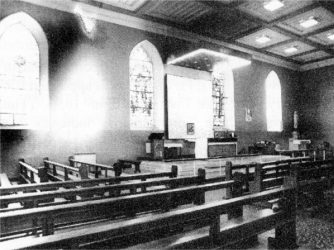
Annaclone Church c.1980. The
church had been extensively renovated, after Vatican
II, in the mid-1960s.
On the death of Canon McAteer, Fr. John Lennon, a
native of Derrymacash, was appointed P.P. He was a very modest man and a
much loved pastor. He will always be remembered as "one who had no
favourites". Fr. Lennon built a parochial hall, which was a great asset
to the parish. He died in 1963 and was succeeded by Fr. Anthony Owens,
formerly Vice-President of St. Colman's College, Newry. Fr. Owens had a
short pastorate as he died suddenly in 1966, just three years later. In
that short space of time he achieved much. He built a new school in
Tullyorier. He also carried out extensive renovations to both Magheral
and Annaclone chapels.
Fr. James McCartan succeeded Fr. Owens in 1966 and
died in 1978. He was a native of Leitrim in Co. Down where many of his
relatives still reside. He built
a new central school in Annaclone known as St.
Colman's. To achieve the amalgamation of the three existing schools, he
had to use all his tact. He was a great diplomat, a wise and good priest
and a man of great integrity.

`OUR OWN TIME'
When Fr. McCartan died in 1978, he was succeeded by
his curate, Fr. James Fitzpatrick (Fr. Jimmy), a Cabra man. Fr. Jimmy
did two spells as curate in Annaclone - one while both Canon McAteer and
Fr. Lennon were P.P.s, and one with Fr. McCartan. He liked Annaclone
very much and the people, in turn, were happy to welcome him as their
parish priest. He was, first and foremost, a priest who had the welfare
of each and every parishioner at heart. Kind and discreet, Fr.
Fitzpatrick was always approachable, especially in times of need and
sickness. He had a great sense of humour and an infectious laugh. It was
during his pastorate that the Community Centre was built. Fr.
Fitzpatrick retired in the summer of 1994.
Fr. Frank Kearney, also from Cabra, became the
current Parish Priest of Annaclone on Sunday, 21st., August 1994. He has
overseen many renovations to the Parochial House and to both churches.
Annaclone Church suffered an arson attack in April 1997, and it was Fr.
Kearney's task to restore the building. Not only did he achieve his
objective, but effected many improvements in the process.
CURATES THROUGH THE YEARS
| Fr. Thomas Brady |
1834 |
| Fr. Bernard
O'Loughlin |
1835 |
| Rev. Fr. Kinney |
1840 |
| Fr. John McDonnell |
1841 |
| Fr. Patrick McIver |
1843 |
| Fr. Patrick
McAnulty |
1848 |
| Fr. Andrew Brennan |
1853 |
| Fr. Stephen Ward |
1855 |
| Fr. John O'Gorman |
1856 |
| Fr. Felix
McLaughlin |
1857 |
| Fr. John McGrath |
1860 |
| Fr. James
McKiverkin |
1863 |
| Fr. Matthew Lynch |
1869 |
| Fr. George McCorry |
1889 |
| Fr. James C. Byrne |
1903 |
| Fr. Henry Doran |
1907 |
| Fr. John Magee |
1913 |
| Fr. (Dr.) O'Hare |
1917 |
| Fr. McComiskey |
1918 |
| Fr. Dargan |
1923 |
| Fr. Dan Fegan |
1925 |
| Fr. Doherty |
1926 |
| Fr. Hugh Fegan |
1929 |
| Fr. Joe Byrne |
1931 |
| Fr. J. McCorry |
1932 |
| Fr. James Murtagh |
1939 |
| Fr. Sweeney |
1945 |
| Fr. Jimmy
Fitzpatrick |
1948 |
| Fr. Mattie O'Hare |
1954 |
| Fr. Bernard Treanor |
1955 |
| Fr. Tom Seymour (Killaloe) |
1960-66 |
| Fr. Jimmy
Fitzpatrick |
1977 |
| Fr. Michael Maginn |
1981 |
| Fr. Joseph
McConville |
1982 |
| Fr. Anthony
O'Reilly |
1983-89 |
| Fr. Jack Murtagh |
1989-93 |
| Fr. John Byrne |
1991 |
|
Presently there is no curate in the parish. |

ANNACLONE'S NATIVE PRIESTS
|
James McKay, (later P.P.) Arthur McArdle |
|
Terence Fegan |
|
John Mackin |
|
Hugh Mooney, (later P.P.) |
|
Thomas McGivern, Ballynanny, later Bishop of
Dromore |
|
Arthur McKay |
|
Henry McGivern, (Ballynanny) |
| Michael McClorey, (Glenburn Road) |
|
Peter McPolin, (Lissize), Southwark |
|
Peter McPolin, (nephew of former) |
|
Arthur McNeill, (formerly P.P. Magheralin,
C.C. Tullylish) |
|
Peter McNeill, (C.C. Warrenpoint) |
ST. COLMAN'S CHURCH, ANNACLONE
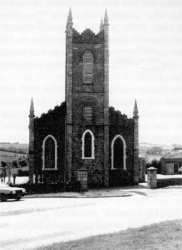
St. Colman's Church, which
replaced an older building, was dedicated by Bishop
Michael Blake in November 1840.
The Church was erected by Rev. J. S. Keenan P.P. to
replace an older building dating from 1802. An old survey map would
indicate that the original building was at right angles to the present
one. Adjacent to the church there were two small buildings. The new
church stood immediately below Monteith Lake in the townland of
Tullintanvally. Following completion, the church was dedicated and
opened by most Rev. Dr. Blake on November, 6th. 1840. The preacher on
the occasion was Rev. Michael Kieran, Drogheda, who was later to become
Archbishop of Armagh.
Fr. Cornelius Woods, P.P., had the church redecorated
and two side-altars added in 1924. A marble High Altar was installed and
consecrated on 26th August 1928. The original latticed windows in the
church were gradually replaced with stained-glass in the course of the
1940s, under the guidance of Canon Edward McAteer, PP
An extensive renovation of Annaclone Church and
re-ordering of the sanctuary was undertaken in the mid-1960s. One of the
existing side-altars was retained so that it could be used as an `altar
of repose' for Holy Week ceremonies. A new octagonal-shaped baptistry
was built around an existing side-entrance
opposite a new high altar. A new entrance porch was
built to enhance parishioners' access to congregational seating and the
choir gallery was enlarged. In addition, the following were installed,
all in mahogany: new seating, two confessionals, a new ambo and credence
table. The original Stations of the Cross, being canvas paintings of
artistic merit, were restored. New lighting and heating replaced the old
systems. A feature of the heating was that it was in tubular form,
amongst the seats and powered by electricity. This project of renovation
cost � 17,000. The architects were Messrs. Smith and Fay, Newry, and the
contractors were Messrs. McDonald Bros., Newry. The priests concerned
with this restructuring were Fr. Anthony Owens P.P., and Fr. James
McCartan, P.P. Fr. Owens died before the work was completed.
St. Colman's Church was blessed and rededicated by
Bishop O'Doherty on Sunday 11th. June 1967. Solemn High Mass on this
occasion was celebrated by Rev. M. O'Hare C.C., Newry, with deacon: Rev.
A. McNeill C.C., Warrenpoint, and sub-deacon: Rev. T. Seymour, C.C.
Banbridge. The Master of Ceremonies was Rev. Fr. J. Lynch, Adm., Newry.
His Lordship, the Bishop presided. Also in the sanctuary were Rev. J.
Burke P.P Clonduff, Rev. F.G. Brooks, St. Colman's College, and Rev. J.
Power S.M.A. Dromantine College. The music was rendered by the
Palestrina Choir, Newry, which was conducted by Rev. S. Moore, C.C.,
Newry. Addressing the congregation, the Most Rev. Dr. O'Doherty traced
the history of the parish and paid tribute to the two priests who were
responsible for the fine work of renovation, namely, Fr. James McCartan
and the late Fr. Anthony Owens. Fr. McCartan then thanked His Lordship
for performing the rededication ceremony and for presiding at the Mass.

ARSON ATTACK
On 15th. April 1997, an alert farmer, some distance
away, noticed smoke billowing from the rear of the chapel. The fire
brigade was on the scene almost immediately and prevented the main
building from catching alight. However the windows, floors, stairs and
furnishings of the upper and lower sacristies were completely destroyed.
The cost of restoration was �50,000 which was defrayed by the Northern
Ireland Office. The reconstruction was extensive. The floors of the two
sacristies were re-constructed from mahogany, as was the connecting
staircase. The furnishings were fashioned from ash and the leaded
windows were restored.
Fr. Frank Kearney P.P. availed of the opportunity to
make several alterations. The seating was reorientated so that it faced
the sanctuary. Several more seats were added and the inter-seat electric
heating system was replaced. It had proved both faulty and expensive to
run. A new Kerosene-fuelled system, employing radiators, was installed
at a cost of �13,000, in its place. In addition the church was re-wired
and new electrical fittings replaced the old. A new canopy was built
over the high altar and a wrought-iron spiral staircase replaced the
wooden one which led up to the choir area. Outside lighting was added
and the church was tastefully re-decorated. This act of arson was a
traumatic experience for a little parish, but nevertheless the church
can truly be said to have been restored to its original grandeur.
The ground for the cemetery was acquired when the
original church was built in Annaclone in 1802. Annaclone Cemetery was
extended in 1980 when one rood of land was bought from Willie Sawey.
CHURCH OF MARY IMMACULATE,
MAGHERAL
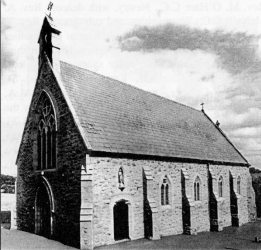
The Church of Mary Immaculate,
Magheral, was built in 1857. An earlier `Mass House'
had occupied this site since 1807.
This church was built by Rev. John Mooney, P.P. in
1857 and was dedicated by Dr. Blake on October 17th. 1858. It replaced
an earlier `Mass House' which had been constructed by Fr. James McKay
P.P. in 1807. Magheral Church was renovated and a new high altar erected
in 1930. This altar was consecrated in November of that year. The church
was closed in 1965 for renovations. The floor, seats and sacristy were
replaced and a re-opening ceremony was held on October 30th. 1965. The
re-opening ceremony was performed by Rev. A. Canon McMullan P.P.,
Dromara, assisted by Rev. A. Owens P.P., Annaclone and Rev. T. Seymour,
C.C. Annaclone. The ceremony was followed by a Solemn Mass at which
Forty Hours' Adoration was inaugurated.
In recent years, under the direction of Father Frank
Kearney P.P., the interior of Magheral Church has been re-arranged and
the church re-decorated. An extra car park, to one side of the church,
has provided much needed parking spaces.
MAGHERAL CEMETERY
The cemetery is contemporaneous with the original Mass
House built, at Magheral, in 1807.
ANNACLONE PAROCHIAL HOUSE
The parochial house, alongside Annaclone Church, was
built in 1851-52 by Rev. John Mooney PP. There was a former priests'
residence at the rear of the church which is now known as the Upper and
Lower Sacristy. The parochial house was renovated in the late 1930s by
Fr. Dan Pullen P.P. The kitchen and housekeeper's quarters were
renovated in 1963 by Fr. Anthony Owens PP The house has been renovated
again, in recent years, by Fr. Frank Kearney P.P.
`Tetelty's Bush' is the first recorded school in
Annaclone Parish. This was a `hedge school' in a hollow in the townland
of Ardbrin, at the bottom of Pat McAvoy's lane. The teacher, Mr. Tetelty,
also used a barn belonging to the McAvoy family. It was in operation
during the eighteenth century. Annaclone Glebe School, a Lancasterian
school, was founded in 1828, and though not a Catholic school, had 25
Catholics on the roll. Ballynafern School, founded in 1827, had 20
Catholics and Tullintanvally National School had 32 Catholics. The
latter was known as `Cuddy's School' because Mr. Cuddy was the teacher.
Although this school had pupils of all denominations, it was visited
regularly by the parish priest and curate. The parish priest in question
was, in all probability, Fr. James McKay.
A SINGLE PARISH SCHOOL
Until recently there were three schools in the
parish. Magheral School was built by Fr. James McKay in 1834 and opened
in 1835. It was closed in June 1971 and is presently a dwelling-house.
Tullyorier School was originally opened in 1861 by Rev. John Mooney. It
was replaced by a new school, built by Rev. Anthony Owens, in 1966. This
school was of short duration for, in 1971, along with Magheral School,
it was amalgamated into the new St. Colman's Primary School of Annaclone.
Monteith School was opened in 1866, also by Fr. John Mooney. When
Monteith was in operation for about one year, it had to be inspected to
see if it were a viable proposition and entitled to a grant (this was
the procedure at the time). Monteith School continued in operation until
the amalgamation of 1971. The new St. Colman's Primary School was opened
in September 1971. The building cost �49,000. Fr. McCartan was P.P. at
this time.
EPILOGUE -
'THE PEOPLE OF ANNA CLONE'
It is, of course, the people of Annaclone who give it
its particular flavour. In many ways, these people are very special.
They are people with great drive, energy and warmth.
Four or five generations ago, the people of the
parish seem to have had this same zeal, for Magheral School, built in
1834, was one of the first built in the Dromore Diocese after the 1831
Education Act. Incidentally, a one-time teacher in Magheral School was a
Miss Durkan, who later became known to generations of pupils in Our
Lady's School in Newry as Sister Mary de Sales.
Annaclone Chapel was opened in 1840 and seems to have
been built in little more than a year. Most of the other churches in the
diocese of Dromore took a much longer time in the building. The
population of the area was then, of course, much greater. The Tithes
Book of 1833, in the Records Office in Belfast, shows that there were
thirty-eight farmsteads in the townland of Ballyshiel. Now there are
only eight. The same could also be said for the other townlands.
Achievement in the parish has, moreover, not been
restricted to the distant past. The building of a magnificent hall in
the summer of 1987 demonstrates this. At that time it was decided to
build a community hall. Firstly a collection was taken up, realising
�12,000. Then the tradesmen of the parish announced that they were
prepared to begin work immediately and that their services would be free
of charge. When Fr. Jimmy Fitzpatrick, our parish priest, performed the
opening ceremony, it was exactly 17 weeks to the day from the first sod
had been cut! This achievement gives us some idea of the calibre of our
present day parishioners. 1 think that very few parishes in Ireland, if
any, could match this mammoth task. A plaque in the anteroom of the hall
says "This hall was built in the summer of 1987 by the voluntary labour
of some of the parishioners and the financial contributions of the
others. It bears testimony to the generosity of spirit of our little
parish of Annaclone". I think this says it all!
Well almost ....I said that they were people of great
warmth. This is made manifest when some student passes an examination,
or some adult prospers in some way or another. Everyone is genuinely
pleased for their success, and makes a point of saying so. An admirable
trait!
Finally, it is worth noting that Patrick Bronte,
father of the famous writers, Charlotte and Emily, was born in our
parish in 1777. He taught in a school in the parish before going to
Cambridge. Bronte preached his first sermon in Drumballyroney Church.
The foundation walls of the cottage where Patrick Bronte was born can
still be seen at Emdale. His mother's house can also still be seen, as
can a larger house to which the family later moved.
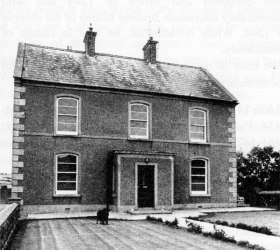
Annaclone Parochial House was
built 1851-52 during the pastorate of Fr. John
Mooney.
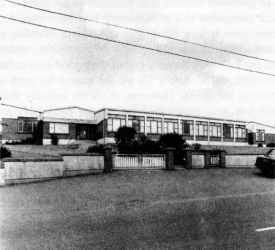
St. Colman's Primary School opened in
September 1971. It involved the amalgamation of Monteith,
Tullyorier and Magheral schools.
 |






